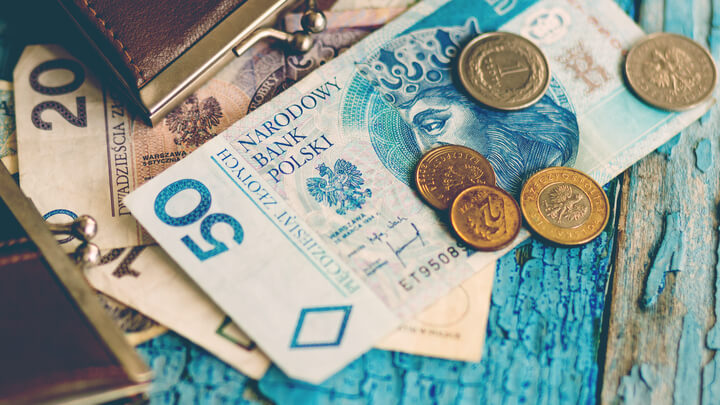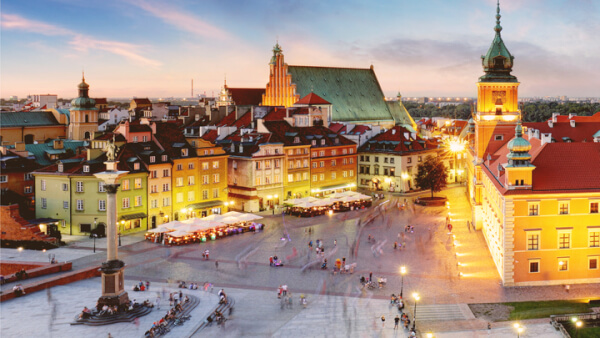ATMs in Poland: Credit cards and fees
Poland’s visitor numbers steadily increase year on year, with tourists and expats alike arriving to hike in the soaring mountains, take a dip along the Baltic...

Dealing with money in a foreign country can be overwhelming. If you’re living, working, or investing in Poland, you may have questions. Here, you’ll find covered the essentials in this financial guide to Poland. Learn more about currency, Poland’s banking institutions, and using your capital.
The official currency is the Polish Zloty, or złoty (pronounced ZWAH-tee).
A few places in Poland will accept the Euro, mostly around the border. However, these places will likely have poor exchange rates, so exchange your money for Zloty at an ATM, bank or local Kantor (Polish exchange service) in order to get the best rates.
| --- | -- |
| Names & Symbols | Złoty, PLN, or zł |
| 1 PLN | There are 100 grosz (gr) in one zloty (zł) |
| PLN coins | The most frequently used coins are zł1, zł2, zł5, 1gr, 2gr, 5gr, 10gr, 20gr, and 50gr. Each grosz coin will have the number value printed on it along with leaves in the amount of the coin’s value. For example, a 20 groszy coin will have 20 leaves – though the coin is so small, it may be hard to tell. A zł1 coin has 100 leaves, while the zł2 and zł5 coins will have two and five leaves respectively. All Polish coins have the state title and the eagle of the coat of arms printed on the reverse. |
| PLN banknotes | Poland’s bank notes are printed in denominations of 10, 20, 50 100, and 200. The different denominations of Zloty bank notes each have their own color. They also have their own distinct, embossed mark in order to help the blind and partially sighted to identify the bank note’s value: zł10 – square, zł20 – circle, zł50 – diamond, zł100 – plus sign, zł200 – triangle |
The best way to exchange currency in Poland is to visit a bank, ATM, or Kantor (currency exchange service).
Kantors are counter exchanges located in spots like hotels, airports or border crossings. They are normally open from 9 AM to 7 PM on weekdays, and until 2 PM on Saturdays. Busy tourist areas may have 24-hour Kantor services.
Banks are easy to find in Poland, especially in larger cities. Be sure to check the hours of a bank before visiting, though, as they vary. ATMs are even more common and can be found at airports, supermarkets, and other popular places. ATMs are available for use 24 hours per day.
The exchange rates will vary, so some suggest shopping around for the best rate. For example, Kantors in larger cities frequently have a better exchange rate than those in smaller towns. You can even negotiate your rate at some Kantors.
As a rule of thumb, you’re looking for the exchange rate that is closest to the interbank (mid-market) exchange rate. The interbank exchange rate is in between the buy rate and the sell rate in global currency markets. If you find a currency exchange that uses that rate, and doesn’t have hidden fees, you should use it.
It is often recommended that you avoid exchanging currency at the airport or hotel, since they have higher rates. When exchanging currency, always ensure your bills are not damaged nor torn, as merchants might not accept them.
In Poland, traveller’s checks can be exchanged at some banks. They cannot, however, be exchanged at Kantors. Traveller’s checks were commonly used in the past as a safe way to carry money abroad but now there are quicker ways of getting cash, like at an ATM. Traveller’s checks have experienced a decline in popularity so you may have trouble finding a bank that will cash your traveller’s check. Banks that do will charge a fee for the service.
Overall, traveller’s checks simply aren’t a great choice. When in Poland, you’re better off using an ATM or a prepaid card.
Credit cards are widely accepted in Poland, especially around tourist attractions. The most commonly used cards are Europay International, MasterCard, Visa, and American Express. If you have a card from a less popular vendor, find out if they can be used in Poland before you go.
Many banks will charge you a foreign transaction fee whenever you purchase something overseas, usually equal to 3%.
Whenever traveling abroad, be sure to inform your card issuer where you are going and when. This way, they won’t erroneously suspect that your card has been stolen and accidentally freeze your card.
When it comes to cash, it’s always recommended to carry some in case of an emergency. However, having large amounts of cash on you can be risky, so only take what you need. Use a credit card or debit card whenever possible to eliminate the need to carry too much cash with you.
ATMs are very common in Poland. Poland has a network of ATMs that are connected to all international networks called bankomat.
Use the online locators to find the nearest ATM for your card to plan where you will get cash once you’re in Poland:
Depending on the ATM and on your bank, you may be charged a variety of fees when using one. Consult with your home bank to see what they will charge you for using an ATM abroad. If your bank charges a flat fee per transaction, try to make large, infrequent withdrawals to prevent paying that fee over and over.
The ATM itself may have its own fees as well. However, it will almost always be cheaper to use an ATM in Poland than to exchange cash from home due to the exchange rate.
If you’re given the option to be charged in your home currency, decline it. Always choose to withdraw in Zloty (local currency) rather than in your home currency when using an ATM. Otherwise, the ATM has license to mark up the exchange rate you’re getting. This is known as ‘Dynamic Currency Conversion’ and it will cause you to pay extra.
It is much easier to bank in Poland than it has been in the past. Up until the 1990s, when Poland had an inefficient, outdated banking system but banking in Poland has improved greatly since then. Today, there are plenty of local and international options.
If you bank with a global bank, you are likely to find a branch or a partner bank in Poland. Check with your home bank before you go – this could help you save money by avoiding fees.
Alternatively, for simple access to the money you need while you’re abroad - and an even better deal - use Wise.
If you have a bank account in Poland, or know someone who does, you can transfer money between bank accounts using the real mid-market exchange rate. You transfer everything using local bank systems, which cuts out those international banking fees - making it a convenient and cheap way to get your cash.
*Please see terms of use and product availability for your region or visit Wise fees and pricing for the most up to date pricing and fee information.
This publication is provided for general information purposes and does not constitute legal, tax or other professional advice from Wise Payments Limited or its subsidiaries and its affiliates, and it is not intended as a substitute for obtaining advice from a financial advisor or any other professional.
We make no representations, warranties or guarantees, whether expressed or implied, that the content in the publication is accurate, complete or up to date.

Poland’s visitor numbers steadily increase year on year, with tourists and expats alike arriving to hike in the soaring mountains, take a dip along the Baltic...

If you’re looking for a city with a taste of the unexpected, Warsaw won’t disappoint. The Polish capital is a city of fascinating contrasts: Modernist...